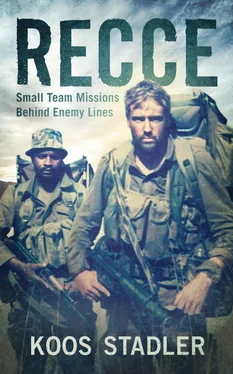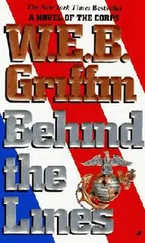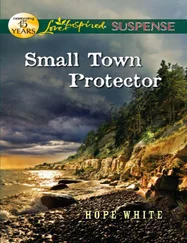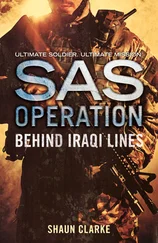The call was made. We would head back and make the best of the situation. For another kilometre we remained vigilant, moving from cover to cover, constantly checking our backs, changing direction and anti-tracking. Then we increased the pace. By first light the next morning we had covered 30 km, and requested a pick-up in the same area where we’d been dropped. Just to make sure the 5 Recce guys did not confuse us with SWAPO, I took off my shirt to expose my white upper body. By mid-morning the Unimogs drove into the RV, and it was a huge relief to see their smiling faces.
In the camp we found 5 Recce preparing for war. Weapons were being cleaned and oiled, vehicles refuelled from the bunkers, camouflage nets pulled tight, food and water secured. The intelligence guys had already drafted a sand model; we just had to fill in the details.
Colonel Hills called all the commanders in for a quick debrief before issuing orders. I ran them through the events of the previous days and described the location of the base, drawing the road and the river line on the sand model. On the map I plotted a six-figure grid reference of where I estimated the centre of the base to be.
Then came the questions.
“How many are there?”
“Did you see any bunkers?”
“How big is the base?”
“What weapons do they have?”
Da Costa and I covered what we could, but in the end the information, from the attackers’ perspective, was sketchy. Finally one of the commando leaders asked, “Are you sure the base is there?”
“The base is there,” I said sternly, “at that grid reference. With vehicles and a lot of people.”
Then one of the commanders asked Colonel Hills, “So what happens if the base is not there?”
“Then 5 Recce will have a new transport park commander,” the OC joked, perhaps in an attempt to break the tension. I was quite amazed that they doubted us – after all our trouble to locate the base. We’d even been ordered to return before we could do a close-in recce.
“The base is there,” I repeated. “I’d put my life on it.”
Dave Drew gave a quick intelligence update, explaining the location of the base and the approximate size. Then James Hills briefed us on the attack. The plan was straightforward. That night I would lead the two stopper groups, 51 and 53 commandos, as well as the mortar platoon, in on the actual line of attack – on foot. Along the route in we would mark the axis of advance with toilet paper to ensure that the main force got to the right position. Once at the forming-up point, exactly three kilometres from the target, we would leave the mortar platoon to deploy in a clearing next to the east-west track. Then we would break away from the attack axis and navigate to a position two kilometres north of the target, where 53 Commando would deploy as a stopper group. This navigation would be by dead reckoning (DR), relying on bearing and distance, as there were no outstanding features in the flat terrain.
Once 53 Commando was in position, I would then navigate to a position three kilometres west of the target, leading the men from 51 Commando to their cut-off position along the east–west road, where we would wait in ambush for any fleeing cadres.
The assault force – regimental HQ, 52 Commando, a company from 101 Battalion, as well as elements from 2 Recce (the Reserve Force contingent that had been called up for the operation) – would follow just before first light. Da Costa would do the navigation to the forming-up point.
The assault force would form up and advance to contact. At first light, as the attackers reached the river line, the mortars would open fire to soften up the target. Then the attack would commence. It seemed straightforward enough.
Before last light that evening, we started moving out. The vehicles took us to within 20 km of the target. Then we set out on foot, found the east–west vehicle track and made good time. By 02:00 we were at the forming-up point. The mortar platoon deployed and set their weapons to fire at the six-figure grid reference I had given as the centre of the base. We marked the forming-up point and the axis of advance with toilet paper, then set out on a bearing to 53 Commando’s position, circumnavigating the target area. This was pure DR navigation, as there were no features to guide us, but I was confident that I had led them to the right position.
We set off for 51 Commando’s position to set up an ambush west of the target. The men were deployed in an extended-line formation next to the road, facing north, the only cover a termite heap behind which the RPG gunner lay. We waited, listening on the radio as the assault force formed up and started their advance to contact. By first light we could actually hear the vehicles, but the order never came for the mortars to open fire.
Then the voice of one of the commando OCs came on the air, “There’s nothing here… No movement. Do you think we have a new transport park commander?”
The response, “Nothing here. It’s a lemon. Sure we have a new –”
Then all hell broke loose.
A DShK 12.7 mm deployed in the ground role created havoc as it covered the eastern entrance to the base. In the opening shots of the attack one of the 52 Commando Casspir drivers, Corporal ML Mashavave, was killed. In the meantime, 53 Commando, having advanced further south because they could not detect any enemy activity, had to withdraw out of the line of fire, missing the opportunity to cut off some of the cadres who were fleeing directly north.
Luckier was 51 Commando. A peculiar-looking SWAPO command vehicle came careening down the track and erupted into a ball of flame as the RPG rocket found its target and bore down on the poor RPG gunner behind his termite mound. Literally centimetres from the frightened man’s face it came to a standstill, half-suspended over the mound.
Seconds later a Gaz 66 truck followed. The RPG gunner, probably still in a state of shock, missed the target, but two operators with SKS rifle grenades planted themselves in the road and stopped it in its tracks, while the rest of the operators blasted away at the driver and passengers.
It turned out that there were a comparatively small number of enemy in the base, as the majority of the cadres were at the rehearsal area twelve kilometres further west. When the attack commenced, the SWAPO HQ and protection element, realising that the attack force was far superior, decided to flee. Thus only a limited number of cadres were killed. Later that morning, as I was sitting in the centre of the base at a bunker that appeared to have been the command centre of the so-called Eastern Front HQ, Captain Robbie Blake, the 51 Commando intelligence officer, drove up in his Casspir, got down and handed me a slip of paper.
“What’s this?” I asked, wondering if there was another target.
“It’s an eight-figure grid reference from the SATNAV (a satellite navigation system and forerunner of the GPS),” he said. “Looks like you were right. It’s the position you gave us.”
I checked my map and realised that the grid reference corresponded exactly with the position of the base I had conveyed to the OC the day before.
In the meantime 52 Commando had reorganised and driven west to engage the rehearsal area. They were ambushed by a large SWAPO force hiding in thick bush on the side of the road, but managed to swing the vehicles into combat formation and fought straight through the ambush site, killing seven enemy. Throughout the rest of that day the three commandos were engaged in follow-up operations. Numerous contacts ensued and a total of 39 SWAPO fighters were killed.
That afternoon, during an ambush laid by more than 100 SWAPO soldiers, Corporal André Renken was killed instantly when 2 Recce’s Casspir was shot out with an RPG. Throughout the day a few operators from 5 Recce were wounded, mostly by shrapnel, and had to be evacuated by helicopter.
Читать дальше












